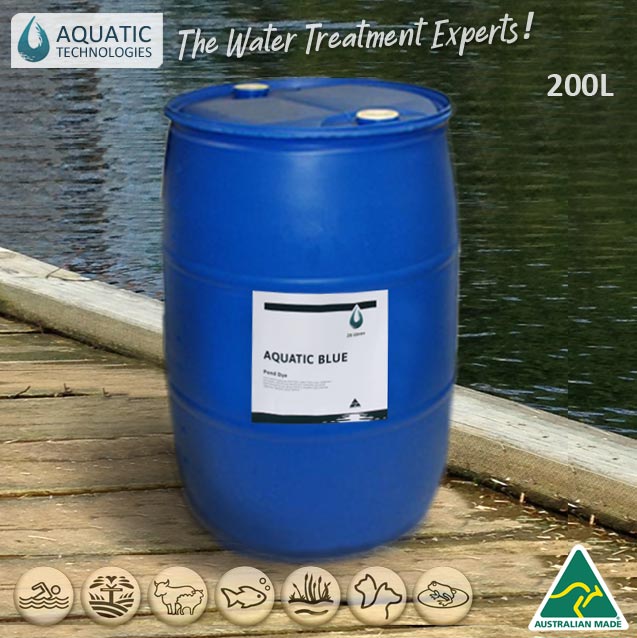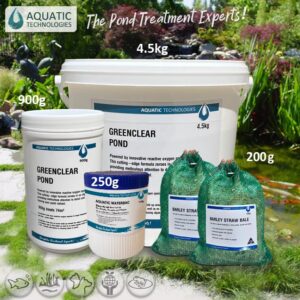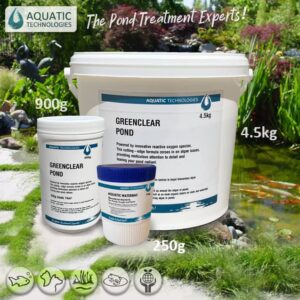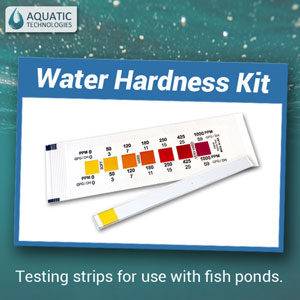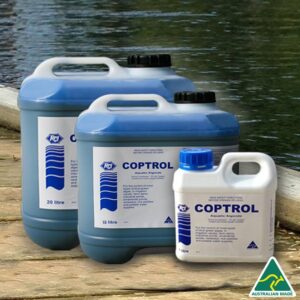Aquatic Blue™ 200L
For the use in Ponds, Dams & Lakes to improve its Visual Appearance, Reduce UV Light in the Water Column and Provide a Deep Blue Colour.
- Transforms water
- Reduces UV Light Penetration through the water
- Visually enhances the water body
- Turns water blue
- Colours the water without increasing turbidity [1]
- Is a safe alternative [2]
- Easy to apply
Enquire about this product
Revitalise Your Water Body with Aquatic Blue: Enhance Appearance and Control Water Quality Issues
With our revolutionary Aquatic Blue dye, you can effortlessly refresh the colour of your water, reduce UV light penetration, and effectively manage water. Our highly concentrated formula ensures vibrant and long-lasting results, surpassing any other dye available on the market. Plus, the added anti-foaming agent makes it perfect for use in fountains and water features.
Safety and Simplicity at Its Best
Rest assured, Aquatic Blue is entirely safe for use around humans, livestock, fish, domestic pets, and wildlife. Once diluted into the water column, it poses no harm to swimming or staining skin, hair, clothes, rocks, or sand. Applying our dye is a breeze – just follow the instructions, measure the required amount, and apply directly into the water or spray for a quick and hassle-free outcome.
Promoting Healthier Waters
Aquatic Blue’s unique light-filtering properties may lead to decreased water temperatures where applied3. This cooling effect plays a vital role in increasing oxygen saturation, which benefits fish health and fosters the growth of beneficial bacteria in your water3. Additionally, the change in water colour due to Aquatic Blue can make fish less visible to predators, thanks to the refraction of light against the blue hue3.
Let’s break it down: Aquatic Blue acts as a barrier, preventing light penetration into the water. Our dye is specifically formulated to filter out red-orange and blue-violet light rays from the sun.
Did You Know?
- Colder water holds more oxygen, benefiting the health of fish and promoting the growth of beneficial bacteria.
- Reducing light intensity in water can help maintain stable pH levels for a longer duration.
The Aquatic Blue Formula
Our innovative blend consists of highly concentrated colourants and dispersants, ensuring even distribution and vibrant colour throughout your water. With Aquatic Blue, you can bid farewell to clumping or sinking dye particles – enjoy a consistent depth of colour and long-lasting effects.
Revive Your Pond with Aquatic Blue
Aquatic Blue is expertly formulated to disperse evenly throughout your water source, creating a visually stunning blue hue that permeates your entire pond. Our dye works quickly and has a lasting effect, providing the perfect solution for maintaining the aesthetic appeal of your water. Say goodbye to clumpy dye particles and embrace a remarkable depth of colour that stands the test of time.

Australian Made Product: Click here for more details.
REFERENCES:
[1] Wisconsin Department of Natural Resources. (2006). Management Options for Aquatic Plants Available: https://www.uwsp.edu/cnr-ap/UWEXLakes/Documents/ecology/Aquatic%20Plants/Appendix-E.pdf
[2] C. S. Tucker and C. C. Mischke, “The Pond Dye, Aquashade, Does Not Prevent Cyanobacterial Off‐Flavors in Pond‐Grown Channel Catfish,” North American Journal of Aquaculture, vol. 82, no. 1, pp. 101-107, 2020.
[3] Tew, K. S. (2003). The impacts of algal control in catfish and percid aquaculture ponds. The Ohio State University.
Step-by-Step Guide: How to Use Aquatic Blue for a Vibrant Water Body
Achieving a stunning water body and reduce UV light penetration has never been easier with Aquatic Blue. Follow these simple steps to make the most of this powerful aquatic dye and enhance your water’s beauty.
- Aquatic Blue is completely safe to use around humans, fish, pets, and livestock. It can be applied to water meant for swimming and irrigation without any concerns. Additionally, Aquatic Blue is highly compatible with chelated copper algaecides like Coptrol, making it a seamless addition to your existing treatment routine.
- Aquatic Blue effectively improves the appearance of water by reducing UV light penetration into and through the water column.
- Experience the impressive features and benefits of Aquatic Blue, including:
- Long-lasting natural blue colour: Enjoy a vibrant and visually appealing blue hue that stands the test of time.
- Easy to use: Aquatic Blue’s user-friendly formula ensures a hassle-free application process.
- Highly concentrated: A little goes a long way with Aquatic Blue, providing exceptional value for your investment. 5L of product dyes 4 Mega Litres of water
- Harmless to fish, wildlife, and humans: Rest assured that Aquatic Blue poses no harm to the living beings in and around your water.
- Sunlight penetration filtering: Aquatic Blue is specially formulated to filter sunlight, improving the water clarity.
- Anti-foaming agent for fountains and water features: Maintain the pristine appearance of your fountains and water features with Aquatic Blue’s anti-foaming properties.
- Highly Compatible: Aquatic Blue seamlessly integrates with chelated copper algaecides like Coptrol, as well as other commonly used chemicals in the aquatic environment. Enjoy the convenience of using Aquatic Blue alongside your preferred treatments.
Achieve a Picture-Perfect Water Body with Aquatic Blue: Transform your water by harnessing the power of Aquatic Blue. Bid farewell to water troubles and embrace the long-lasting, vibrant blue colour that enhances the beauty of your water.

- Water Colourant
- Ponds, Dams and Lakes
- UV Light
What are the benefits of using Aquatic Blue water dye?
Aquatic Blue is a professional water dye that offers a multitude of benefits. Experience the desired blue aesthetic while reducing UV light and improving water quality. By limiting light availability in the water column, the reflected sunlight from the blue colour may also help maintain lower water temperatures, which in turn promotes higher oxygen levels beneficial for fish health and the growth of essential bacteria.
Is Aquatic Blue harmful to fish and other wildlife?
Rest assured, Aquatic Blue is completely safe for fish, frogs, wildlife, humans, pets, and livestock. It has been carefully formulated to ensure harmlessness while providing optimal results. You can swim and enjoy your water body without any concerns.
Are lake dyes safe to use?
Absolutely! Aquatic Blue is not only safe but also incredibly easy to use. It poses no harm to fish, frogs, livestock, pets, or humans. With Aquatic Blue, you can confidently enhance the aesthetic appeal and water quality of your water body.
Why do people dye ponds and lakes?
The reasons for dyeing ponds and lakes are manifold. By using Aquatic Blue, you can enhance the visual appeal of your water body while reducing UV light penetration through the water column. The result is not only a visually pleasing pond or lake but also improved water quality that can support the health and longevity of aquatic life.
Will Aquatic Blue dye stain rocks?
No, Aquatic Blue is a safe and user-friendly dye. When fully diluted, it will not stain rocks, pets, livestock, or anyone swimming in the water. Enjoy the benefits of Aquatic Blue without worrying about unwanted stains or discoloration.
Will Aquatic Blue stain Sandstone, machinery or water features?
No, when fully diluted, Aquatic Blue will not stain sandstone, machinery or any other water features you may have.
Is Aquatic Blue safe for livestock?
Yes, Aquatic Blue is an industrial food grade standard product. When it is fully diluted, it is completely safe for your livestock watering.
Have More Questions? Reach Out to Us
If you have further enquiries or need additional information, our team is ready to assist you. Contact us today for expert guidance and make the most of Aquatic Blue to enhance your water with confidence.
Can I use Aquatic Blue in my swimming pool?
No. Aquatic Blue will react with chlorinated and salt chlorinated water and turn your pool into a yellow/brown colour.
Description
Revitalise Your Water Body with Aquatic Blue: Enhance Appearance and Control Water Quality Issues
With our revolutionary Aquatic Blue dye, you can effortlessly refresh the colour of your water, reduce UV light penetration, and effectively manage water. Our highly concentrated formula ensures vibrant and long-lasting results, surpassing any other dye available on the market. Plus, the added anti-foaming agent makes it perfect for use in fountains and water features.
Safety and Simplicity at Its Best
Rest assured, Aquatic Blue is entirely safe for use around humans, livestock, fish, domestic pets, and wildlife. Once diluted into the water column, it poses no harm to swimming or staining skin, hair, clothes, rocks, or sand. Applying our dye is a breeze – just follow the instructions, measure the required amount, and apply directly into the water or spray for a quick and hassle-free outcome.
Promoting Healthier Waters
Aquatic Blue’s unique light-filtering properties may lead to decreased water temperatures where applied3. This cooling effect plays a vital role in increasing oxygen saturation, which benefits fish health and fosters the growth of beneficial bacteria in your water3. Additionally, the change in water colour due to Aquatic Blue can make fish less visible to predators, thanks to the refraction of light against the blue hue3.
Let’s break it down: Aquatic Blue acts as a barrier, preventing light penetration into the water. Our dye is specifically formulated to filter out red-orange and blue-violet light rays from the sun.
Did You Know?
- Colder water holds more oxygen, benefiting the health of fish and promoting the growth of beneficial bacteria.
- Reducing light intensity in water can help maintain stable pH levels for a longer duration.
The Aquatic Blue Formula
Our innovative blend consists of highly concentrated colourants and dispersants, ensuring even distribution and vibrant colour throughout your water. With Aquatic Blue, you can bid farewell to clumping or sinking dye particles – enjoy a consistent depth of colour and long-lasting effects.
Revive Your Pond with Aquatic Blue
Aquatic Blue is expertly formulated to disperse evenly throughout your water source, creating a visually stunning blue hue that permeates your entire pond. Our dye works quickly and has a lasting effect, providing the perfect solution for maintaining the aesthetic appeal of your water. Say goodbye to clumpy dye particles and embrace a remarkable depth of colour that stands the test of time.

Australian Made Product: Click here for more details.
REFERENCES:
[1] Wisconsin Department of Natural Resources. (2006). Management Options for Aquatic Plants Available: https://www.uwsp.edu/cnr-ap/UWEXLakes/Documents/ecology/Aquatic%20Plants/Appendix-E.pdf
[2] C. S. Tucker and C. C. Mischke, “The Pond Dye, Aquashade, Does Not Prevent Cyanobacterial Off‐Flavors in Pond‐Grown Channel Catfish,” North American Journal of Aquaculture, vol. 82, no. 1, pp. 101-107, 2020.
[3] Tew, K. S. (2003). The impacts of algal control in catfish and percid aquaculture ponds. The Ohio State University.How To Use
Step-by-Step Guide: How to Use Aquatic Blue for a Vibrant Water Body
Achieving a stunning water body and reduce UV light penetration has never been easier with Aquatic Blue. Follow these simple steps to make the most of this powerful aquatic dye and enhance your water’s beauty.
- Aquatic Blue is completely safe to use around humans, fish, pets, and livestock. It can be applied to water meant for swimming and irrigation without any concerns. Additionally, Aquatic Blue is highly compatible with chelated copper algaecides like Coptrol, making it a seamless addition to your existing treatment routine.
- Aquatic Blue effectively improves the appearance of water by reducing UV light penetration into and through the water column.
- Experience the impressive features and benefits of Aquatic Blue, including:
- Long-lasting natural blue colour: Enjoy a vibrant and visually appealing blue hue that stands the test of time.
- Easy to use: Aquatic Blue’s user-friendly formula ensures a hassle-free application process.
- Highly concentrated: A little goes a long way with Aquatic Blue, providing exceptional value for your investment. 5L of product dyes 4 Mega Litres of water
- Harmless to fish, wildlife, and humans: Rest assured that Aquatic Blue poses no harm to the living beings in and around your water.
- Sunlight penetration filtering: Aquatic Blue is specially formulated to filter sunlight, improving the water clarity.
- Anti-foaming agent for fountains and water features: Maintain the pristine appearance of your fountains and water features with Aquatic Blue’s anti-foaming properties.
- Highly Compatible: Aquatic Blue seamlessly integrates with chelated copper algaecides like Coptrol, as well as other commonly used chemicals in the aquatic environment. Enjoy the convenience of using Aquatic Blue alongside your preferred treatments.
Achieve a Picture-Perfect Water Body with Aquatic Blue: Transform your water by harnessing the power of Aquatic Blue. Bid farewell to water troubles and embrace the long-lasting, vibrant blue colour that enhances the beauty of your water.

Targets
- Water Colourant
- Ponds, Dams and Lakes
- UV Light
FAQ
What are the benefits of using Aquatic Blue water dye?
Aquatic Blue is a professional water dye that offers a multitude of benefits. Experience the desired blue aesthetic while reducing UV light and improving water quality. By limiting light availability in the water column, the reflected sunlight from the blue colour may also help maintain lower water temperatures, which in turn promotes higher oxygen levels beneficial for fish health and the growth of essential bacteria.
Is Aquatic Blue harmful to fish and other wildlife?
Rest assured, Aquatic Blue is completely safe for fish, frogs, wildlife, humans, pets, and livestock. It has been carefully formulated to ensure harmlessness while providing optimal results. You can swim and enjoy your water body without any concerns.
Are lake dyes safe to use?
Absolutely! Aquatic Blue is not only safe but also incredibly easy to use. It poses no harm to fish, frogs, livestock, pets, or humans. With Aquatic Blue, you can confidently enhance the aesthetic appeal and water quality of your water body.
Why do people dye ponds and lakes?
The reasons for dyeing ponds and lakes are manifold. By using Aquatic Blue, you can enhance the visual appeal of your water body while reducing UV light penetration through the water column. The result is not only a visually pleasing pond or lake but also improved water quality that can support the health and longevity of aquatic life.
Will Aquatic Blue dye stain rocks?
No, Aquatic Blue is a safe and user-friendly dye. When fully diluted, it will not stain rocks, pets, livestock, or anyone swimming in the water. Enjoy the benefits of Aquatic Blue without worrying about unwanted stains or discoloration.
Will Aquatic Blue stain Sandstone, machinery or water features?
No, when fully diluted, Aquatic Blue will not stain sandstone, machinery or any other water features you may have.
Is Aquatic Blue safe for livestock?
Yes, Aquatic Blue is an industrial food grade standard product. When it is fully diluted, it is completely safe for your livestock watering.
Have More Questions? Reach Out to Us
If you have further enquiries or need additional information, our team is ready to assist you. Contact us today for expert guidance and make the most of Aquatic Blue to enhance your water with confidence.
Can I use Aquatic Blue in my swimming pool?
No. Aquatic Blue will react with chlorinated and salt chlorinated water and turn your pool into a yellow/brown colour.
Resources
Videos
Safe For


